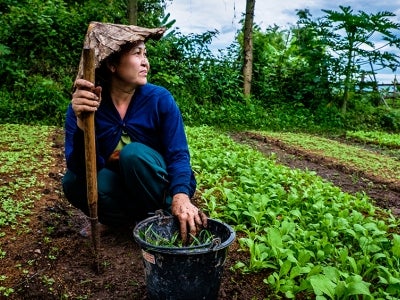by Camilla Nordheim-Larsen
Global Mechanism
27 November 2012 - As Myanmar sets out on the parallel tracks of economic development and environmental conservation, it held a workshop in its capital, Nay Pyi Taw, from 8 to 10 November 2012, to strengthen the capacities of government officials to access funding for climate change adaptation and mitigation projects and programmes. The participants of the three-day workshop, which was co-organized by the Global Mechanism (GM), Global Environment Facility (GEF) and Food and Agriculture Organization of the UN (FAO), gained insight on attaining funding for projects that promote sustainable forest and land management (SFM and SLM) while helping to cope with climate change.
The workshop underscored the technical and financial links between resource degradation and climate change in the agriculture, forestry and other land uses (AFOLU) sector. Participants learned how to locate financing mechanisms as well as how to develop climate change adaptation and mitigations projects in AFOLU.
The GM is currently working with Myanmar and partner organizations, the GEF and FAO, to support a comprehensive approach to sustainable land and natural resource management as economic reforms take hold. An integrated financing strategy (IFS) for SLM is expected by the end of the year, a sign of Myanmar President Thein Sein’s intention “to give top priorities to the policies on internal affairs to achieve sustainable development.” In his 30 March 2011 inaugural speech, Thein Sein professed, “We will pay serious attention to conservation of forests and woodlands and take measures in various sectors to reduce air and water pollution, control dumping of industrial waste and conserve wildlife.”
Myanmar’s emergence from economic isolation recently made world headlines when, for the first time, a sitting U.S. president paid a visit. Speaking about democratic ideals at the University of Yangon on 19 November 2012, President Barack Obama noted, “This country is famous for its natural resources, and they must be protected against exploitation,” referring to the land endowed with natural gas, minerals and possibly oil where agriculture, forestry, livestock and fisheries account for much of the economy.
In line with the first Millennium Development Goal, the overall purpose of the programme the GM is promoting is to ensure sustained and adequate investment flows to SFM and SLM in the nation formerly known as Burma. Placing a ‘true’ value on land, ensuring long-term investments in SLM and increasing resilience to climate change should enhance the lives of rural Myanmar populations, including those who reside in fragile and degraded lands.
Living alongside one of the richest biodiversities in Asia, Myanmar’s 60 million residents, most of whom make a living in agriculture, fisheries or forestry, find their livelihoods deeply impacted by the more frequent and severe cyclones, landslides, droughts and floods. The Dry Zone, which covers large parts of the Magway, Mandalay and lower Sagaing Divisions in the centre of the country, receives less rainfall than other areas and is one of the most food insecure regions in the country. Characterized by clay and sandy soils which are at high risk of water and wind erosion, the Dry Zone is particularly susceptible to changes in climatic patterns, as evidenced by the recent irregular and reduced amount of rainfall and repeated occurrences of drought.
For more information:
Ms Camilla Nordheim-Larsen, Programme Coordinator, Asia and Pacific, +39 06 5459 2061,
c.nordheim-larsen@global-mechanism.org


